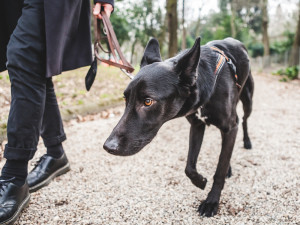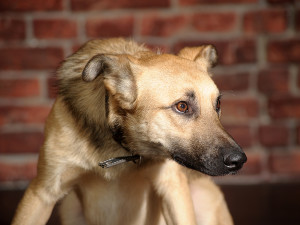How to Cure Your Dog’s Case of the Everyday Scaries
There’s nothing to fear but fear itself — and a dog who won’t stop shaking when it thunders.

Share Article
There is no guidebook to pet parenting. In fact, you probably don’t ever want unsolicited advice from your neighbor’s cousin’s girlfriend on how to train your new puppy. But, much like regular parenting, there is a lot of misinformation out there about what you should do in any situation, like when your puppy is scared, crying, or needs a cuddle.
Many pet parents have been taught that trying to soothe frightened dogs just makes them worse. It seems logical: Your pup hears thunder, they run to you and you pet them. Voilà, your dog just got reinforced for running to you when it thunders, and worse, for being afraid of thunderstorms in the first place. But that’s not what actually happens!

Get (totally free) deals for food, treats, accessories, tech, and way more pet parenting must-haves.
opens in a new tabFirst, no amount of petting is going to make it worthwhile for your pup to work themselves into a panic for no reason. Fear is no more fun for dogs than it is for people; they wouldn‘t put themselves in that state on purpose. The function of fear is to signal the body that there is danger present, and that the individual feeling fearful had better do something to make the danger, and the fear that accompanies it, go away.
Think of it this way: Imagine you’re eating ice cream when someone tries to break into your house at midnight. Would the pleasure of eating ice cream “reinforce” you for being afraid, so that you’d be more afraid the next time? If anything, things would work in the reverse — you might develop an unconscious discomfort around ice cream. However, you sure as heck aren’t going to be more afraid if a burglar arrives just because you were eating mint-chocolate chip the first time it happened.
Studying Stress
There’s another reason why petting your thunder-phobic dog doesn’t make them worse: Research on thunder-phobic dogs suggests that petting does not decrease the level of stress in the dog receiving it. The authors measured the production of cortisol, a hormone related to stress. They found that cortisol levels did not decrease when the dogs were being petted by their guardians during storms. (The most important factor in decreasing cortisol was the presence of other dogs.)
Interestingly, another piece of research on social bonding found that although cortisol levels decrease in people when they are interacting with dogs, cortisol does not decrease in dogs in the same context. However, in both species, other hormones and neurotransmitters increased, including oxytocinopens in a new tab, prolactin and beta-endorphin — all substances that are associated with good feelings and social bonding. So, while petting your dog during a storm may not decrease cortisol levels, it is still possible that something good could be happening.
On the contrary, it’s just not possible that petting your dogopens in a new tab is going to make them more fearful the next time there’s a storm. Feel free to offer them all the comfort you can, especially if they are into physical affectionopens in a new tab.
A Classical Approach
The greatest damage that’s done with outdated “don’t pet the dog” advice doesn’t relate to storms but to the pitfalls of trying to explain classical counter-conditioning (CCC). CCC can be a profoundly effective way to change behavior, because it changes the emotions that drive the behavior in the first place. A typical example in applied animal behavior is having visitors throw treats to a dog who is afraid of strangers.
Understandably, many humans have asked, “But isn’t giving treats when they’re barking and growling opens in a new tabjust going to make it worse? Won’t they get reinforced for barking and growling?” The answer is no — not if their behavior is driven by fear. Remember, fear is no fun, and a few pieces of food, no matter how yummy, aren’t going to override the brain’s desire to avoid it.
Tossing treats (or toys) to a fearful dogopens in a new tab can teach them to associate approaching strangers with something good, as long as the treat is really, really good, and the visitor is far enough away to avoid overwhelming the dog. CCC is one of the most important tools in a trainer or behaviorist’s toolbox, yet it can be hard to convince people to try it. It feels like rewarding a dog for misbehaving, and in our punishment-oriented, “you’ve got to get dominance over your dogopens in a new tab” society, it is tough for some people to do.
CCC is one of many ways you can help a thunder-phobic dog. I’ve used some of the following with good success, either on their own or combined with other methods: pheromone therapy, wraps, acupuncture, acupressure, diet change, and, in serious cases, medication. If your dog is afraid of storms, you’d do well to consult a behaviorist or veterinary behaviorist for assistance in choosing the method that is right for you and your pup.
Fear Is Contagious
Your dog watches what you do, and they trust you. So, if you are scared about something, your pup will pick up on that and might get even more afraid. The emotion of fear is so compelling that it is easy to spread around. “Emotional contagion” is the term used to describe the viral spread of fear within a group, and it’s a common occurrence among social species. If you’re afraid of storms, it is entirely possible that your dog will pick up on it and become more nervous.
However, if you are freaked out (and who isn’t sometimes?), all is not lost. You can calm things downopens in a new tab by concentrating on your body — slowing down your breathing and your movements, changing your posture to one of confidence and relaxation, and speaking slowly and calmly (if at all). These actions have the beneficial effect of altering your own emotions as well as your dog’s.
The calmer you pretend to be, the calmer you’ll actually feel. And your dog, who looks to you with those adorable puppy-dog eyes, will chill out, too.
Sources:
Nancy Dreschel, DVM, & Douglas Granger, PhD. 2005. “Physiological and behavioral reactivity to stress in thunderstorm-phobic dogs and their caregivers,” Applied Animal Behaviour Science 95:153–168.
J.S.J. Odendaal & R.A. Meintjes. 2003. “Neurophysiological correlates of affiliative behaviour between humans and dogs.” The Veterinary Journal 165:296-301.

Patricia McConnell, PhD
Patricia McConnell, PhD, is an animal behaviorist and ethologist and an adjunct associate professor in zoology at the University of Wisconsin, Madison, as well as the author of numerous books on behavior and training.
Related articles
![Pet parent comforting anxious dog by holding their paw]() opens in a new tab
opens in a new tabHow to Help an Anxious Dog
Easy ways to calm your pup’s nerves.
![A dog looking up with a cute face]() opens in a new tab
opens in a new tabHow to Get Your Scared Dog to Trust You
Using these tips, your skittish dog will warm up to you.
![Smiling woman sits on the lawn with her dog in the city]() opens in a new tab
opens in a new tabPlease, Oh Please, Stop Perpetuating the Dominance Dog Theory
The idea of being a dog’s “alpha” is a popular one — but it’s not an effective way to train.
- opens in a new tab
How to Manage Leash Reactivity in Your Dog
If your pup acts diabolical on walks, you are not alone. Here’s what you can do.







